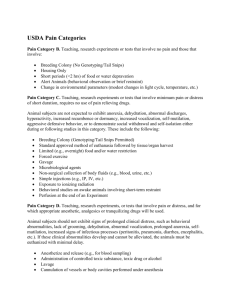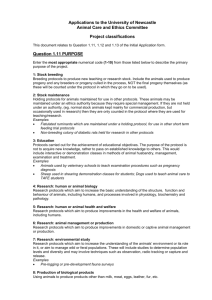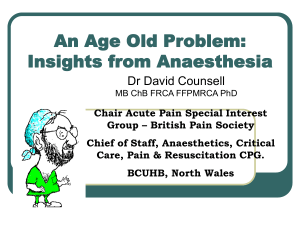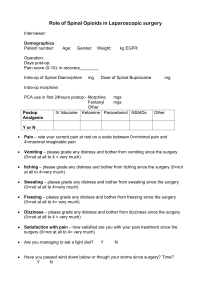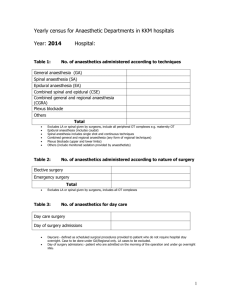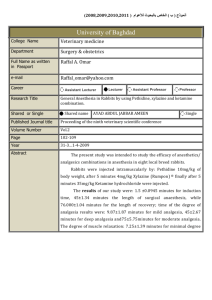BUREAU OF ANIMAL WELFARE (BAW) Classification for t
advertisement
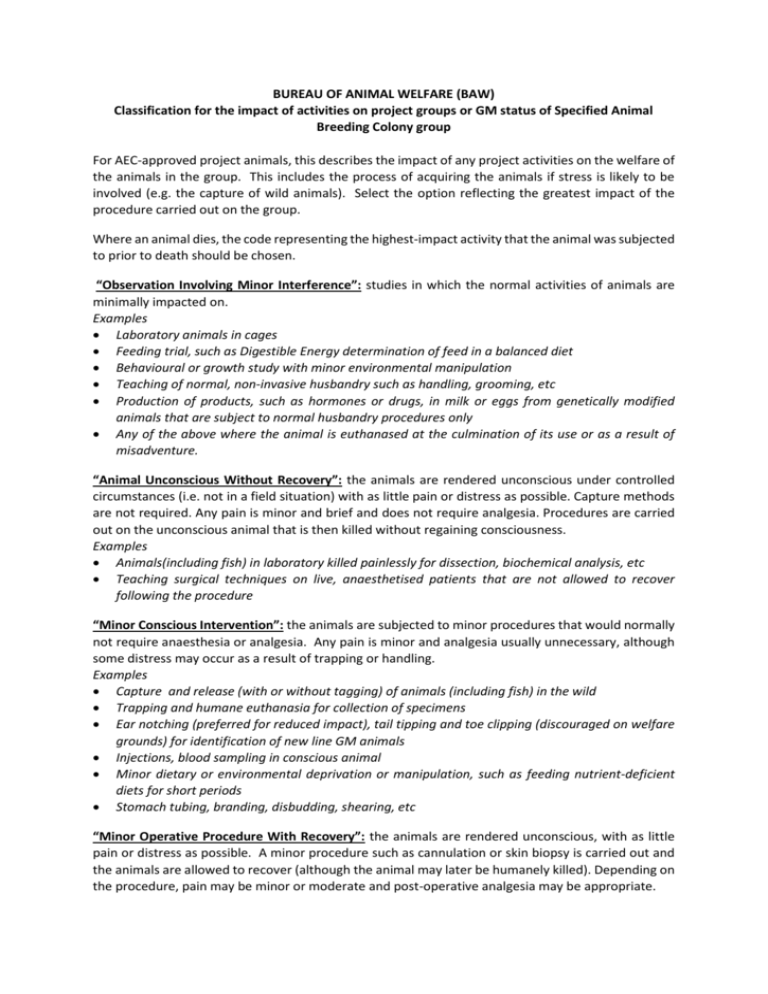
BUREAU OF ANIMAL WELFARE (BAW) Classification for the impact of activities on project groups or GM status of Specified Animal Breeding Colony group For AEC-approved project animals, this describes the impact of any project activities on the welfare of the animals in the group. This includes the process of acquiring the animals if stress is likely to be involved (e.g. the capture of wild animals). Select the option reflecting the greatest impact of the procedure carried out on the group. Where an animal dies, the code representing the highest-impact activity that the animal was subjected to prior to death should be chosen. “Observation Involving Minor Interference”: studies in which the normal activities of animals are minimally impacted on. Examples Laboratory animals in cages Feeding trial, such as Digestible Energy determination of feed in a balanced diet Behavioural or growth study with minor environmental manipulation Teaching of normal, non-invasive husbandry such as handling, grooming, etc Production of products, such as hormones or drugs, in milk or eggs from genetically modified animals that are subject to normal husbandry procedures only Any of the above where the animal is euthanased at the culmination of its use or as a result of misadventure. “Animal Unconscious Without Recovery”: the animals are rendered unconscious under controlled circumstances (i.e. not in a field situation) with as little pain or distress as possible. Capture methods are not required. Any pain is minor and brief and does not require analgesia. Procedures are carried out on the unconscious animal that is then killed without regaining consciousness. Examples Animals(including fish) in laboratory killed painlessly for dissection, biochemical analysis, etc Teaching surgical techniques on live, anaesthetised patients that are not allowed to recover following the procedure “Minor Conscious Intervention”: the animals are subjected to minor procedures that would normally not require anaesthesia or analgesia. Any pain is minor and analgesia usually unnecessary, although some distress may occur as a result of trapping or handling. Examples Capture and release (with or without tagging) of animals (including fish) in the wild Trapping and humane euthanasia for collection of specimens Ear notching (preferred for reduced impact), tail tipping and toe clipping (discouraged on welfare grounds) for identification of new line GM animals Injections, blood sampling in conscious animal Minor dietary or environmental deprivation or manipulation, such as feeding nutrient-deficient diets for short periods Stomach tubing, branding, disbudding, shearing, etc “Minor Operative Procedure With Recovery”: the animals are rendered unconscious, with as little pain or distress as possible. A minor procedure such as cannulation or skin biopsy is carried out and the animals are allowed to recover (although the animal may later be humanely killed). Depending on the procedure, pain may be minor or moderate and post-operative analgesia may be appropriate. Examples Biopsies or blood sampling under anaesthesia or sedation Cannulations under anaesthesia or sedation Sedation/anaesthesia for relocation, examination or injections/blood sampling Field capture using chemical restraint methods “Surgery With Recovery”: generally the animals are rendered unconscious, with as little pain or distress as possible. A major procedure such as abdominal or orthopaedic surgery is carried out and the animals are allowed to recover (although the animal may later be humanely killed). Post operative pain is usually considerable and at a level requiring analgesia. Examples Orthopaedic surgery Abdominal or thoracic surgery Transplant surgery Mulesing, surgical castration without anaesthesia Surgery under anaesthesia for implantation of telemetry tags “Minor Physiological Challenge”: the animals remain conscious for some or all of the procedure. There is interference with the animals’ physiological or psychological processes. The challenge may cause only a small degree of pain/distress or any pain/distress is quickly and effectively alleviated. Examples Minor infection, minor or moderate phenotypic modification, early oncogenesis Arthritis studies with pain alleviation. Prolonged deficient diets, induction of metabolic disease. Polyclonal antibody production Antiserum production “Moderate to Major Physiological Challenge”: the animals remain conscious for some or all of the procedure. There is interference with the animals’ physiological or psychological processes. The challenge causes a moderate or large degree of pain/distress that is not quickly or effectively alleviated. Examples Major infection, major phenotypic modification, oncogenesis without pain alleviation Arthritis studies with no pain alleviation, uncontrolled metabolic disease Isolation or environmental deprivation for extended periods Monoclonal antibody raising in mice (discouraged – alternatives are available) “Specified Animal Breeding Colony group: non-GM breeding only”: routinely bred specified animals with no genetic modification. “Specified Animal Breeding Colony group: established GM line breeding”: specified animals that have undergone genetic modification (or are from lines of animals resulting from genetic modification) according to AEC-approved SOPs.

